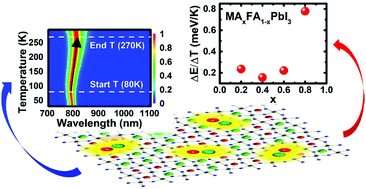Influence of mixed organic cations on the structural and optical properties of lead tri-iodide perovskites†
Abstract
Perovskites with mixed organic cations possess better properties in some aspects as compared to their pure counterparts. However, the structural and optical properties of these mixed-type perovskites have been rarely investigated. In this study, probable structures of mixed organic cation perovskites, MAxFA1−xPbI3 (x = 1, 0.8, 0.6, 0.4 and 0.2), were comparatively discussed. Saturation of excitonic emission at 1.66 eV indicates limited orthorhombic phase at 30 K in MAPbI3, which confirms the co-existence of orthorhombic and tetragonal phases at low temperatures. Based on the comprehensive temperature- and power-dependent measurements, it is found that defects are activated in mixed organic cation perovskites under low excitation power at room temperature, whereas this process is not observed in pure MAPbI3. At high excitation power, free exciton recombination is suppressed due to exciton–exciton interaction for all samples. Analysis of stability against temperature based on these photoemission processes shows that the structure with comparable organic cation proportion is more stable; this can be explained by uniformly distributed strains existing at the boundaries between MAPbI3 and FAPbI3 molecules. These analyses of structural and optical properties of mixed organic cation perovskites are meaningful in dictating the future optoelectronic devices.

- This article is part of the themed collection: 2019 Nanoscale HOT Article Collection


 Please wait while we load your content...
Please wait while we load your content...